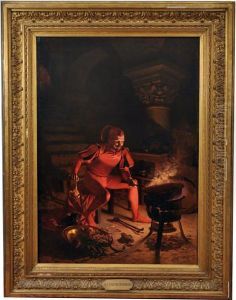Felix Aug. Bauer Paintings
Felix Aug. Bauer was a multifaceted Austrian artist born in 1864 in the Austro-Hungarian Empire. His life spanned a period of significant socio-political changes in Europe, which influenced the realms of art and culture profoundly. Bauer was not just an artist in the traditional sense; his work encompassed painting, illustration, and graphic arts, showcasing a versatility that was quite remarkable for his time.
Bauer's early life was marked by an immersion in the rich cultural milieu of Vienna, a city that was a melting pot of artistic innovation and intellectual discourse. This environment undoubtedly shaped his artistic sensibilities and trajectory. He received his formal education in art at the Academy of Fine Arts Vienna, an institution renowned for its rigorous training and for nurturing some of the most prominent artists in European history. Here, Bauer honed his skills in various mediums and developed a keen eye for detail, which would become a hallmark of his work.
Throughout his career, Felix Aug. Bauer contributed significantly to the art scene in Austria and beyond. He was known for his exquisite landscapes and portraiture, capturing the essence of his subjects with a realism that was both poignant and captivating. His landscapes, often depicting the Austrian countryside, were celebrated for their naturalistic detail and atmospheric depth, reflecting a deep appreciation for the natural world.
Bauer's work also delved into the realm of illustration and graphic arts, where he demonstrated a remarkable ability to convey complex narratives through visual means. He illustrated books and periodicals, bringing literary works to life with his intricate designs and thoughtful compositions. This aspect of his work highlights his versatility as an artist and his ability to engage with a diverse range of subjects and themes.
Despite his contributions to the arts, Felix Aug. Bauer remains a somewhat enigmatic figure, with his life and work deserving of further research and recognition. He passed away in 1922, leaving behind a legacy that reflects the richness of the turn-of-the-century European art scene. Bauer's art continues to be appreciated by connoisseurs and scholars alike, serving as a testament to his skill, vision, and the enduring value of his artistic endeavors.
